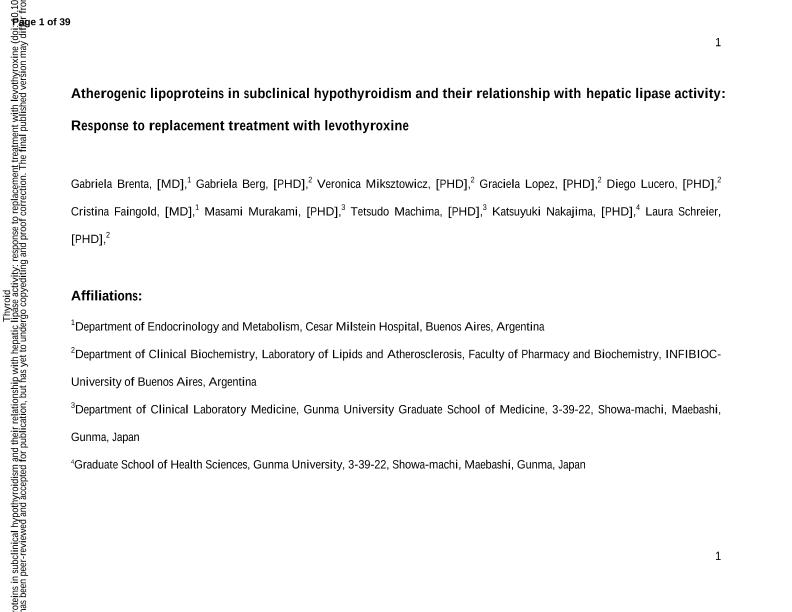Artículo
Atherogenic lipoproteins in subclinical hypothyroidism and their relationship with hepatic lipase activity: Response to replacement treatment with levothyroxine
Brenta, Gabriela; Berg, Gabriela Alicia ; Miksztowicz, Verónica Julieta
; Miksztowicz, Verónica Julieta ; Lopez, Graciela Ines; Lucero, Diego Martín
; Lopez, Graciela Ines; Lucero, Diego Martín ; Faingold, María Cristina; Murakami, Masami; Machima, Tetsudo; Nakajima, Katsuyuki; Schreier, Laura Ester
; Faingold, María Cristina; Murakami, Masami; Machima, Tetsudo; Nakajima, Katsuyuki; Schreier, Laura Ester
 ; Miksztowicz, Verónica Julieta
; Miksztowicz, Verónica Julieta ; Lopez, Graciela Ines; Lucero, Diego Martín
; Lopez, Graciela Ines; Lucero, Diego Martín ; Faingold, María Cristina; Murakami, Masami; Machima, Tetsudo; Nakajima, Katsuyuki; Schreier, Laura Ester
; Faingold, María Cristina; Murakami, Masami; Machima, Tetsudo; Nakajima, Katsuyuki; Schreier, Laura Ester
Fecha de publicación:
03/2016
Editorial:
Mary Ann Liebert
Revista:
Thyroid
ISSN:
1050-7256
Idioma:
Inglés
Tipo de recurso:
Artículo publicado
Clasificación temática:
Resumen
Background: Qualitative lipoprotein changes, such as an increase in fasting remnants, are reported in subclinical hypothyroidism (SCH). It was hypothesized that such changes are due to reduced hepatic lipase (HL) activity in SCH: HL is an enzyme regulated by thyroid hormones, and is involved in the degradation of triglyceride (TG)-rich remnants. This study aimed to quantify remnant-like lipoproteins (RLP), small dense LDL (sdLDL), and HL activity in women with SCH, and to assess these parameters after levothyroxine replacement therapy. Methods: This was an observational cross-sectional study with a subsequent longitudinal follow-up. Findings in women with thyrotropin levels >4.5 mIU/L (SH group) were compared with age- and body mass index (BMI)-matched euthyroid women (control group). In addition, a subgroup analysis was undertaken in SCH women who chose to receive levothyroxine treatment (0.9 μg/kg/day) for 6 months. RLP was quantified by measuring cholesterol (RLP-C) and triglycerides (RLP-TG) after immunoaffinity chromatography, and sdLDL by automated standardized methods; HL activity was measured in post-heparin plasma. Results: The SCH group included 37 women; 29 women were included in the control group. In addition, 22 women with SCH were included in the subgroup analysis (levothyroxine treatment). Significantly higher RLP values were observed in the SCH group than in the control group: RLP-C (median [range], mg/dL): 20.3 (5.8-66.8) versus 10.2 (2.7-36.3), p = 0.005; RLP-TG (mg/dL): 26.3 (3.2-123.3) versus 12.1 (2.5-61.6), p = 0.033. HL activity (mean ± standard deviation [SD], μmol free fatty acid/mL post-heparin plasma.h) - 9.83 ± 4.25 versus 9.92 ± 5.20, p = 0.707 - and sdLDL levels (mg/dL) - 23.1 ± 10.7 versus 22.6 ± 8.4, p = 0.83 - were similar. After levothyroxine, RLP-C decreased - 21.5 (5.8-66.8) versus 17.2 (4.1-45.6), p = 0.023 - and HL increased - 9.75 ± 4.04 versus 11.86 ± 4.58, p = 0.012 - in the subgroup of SCH women. No changes in sdLDL were observed. Conclusions: Women with SCH have higher RLP levels than matched controls do, but their RLP-C levels decrease significantly following levothyroxine therapy. Furthermore, HL activity also increases after levothyroxine therapy and can be interpreted as a possible explanation for the decrease in RLP-C.
Archivos asociados
Licencia
Identificadores
Colecciones
Articulos(OCA HOUSSAY)
Articulos de OFICINA DE COORDINACION ADMINISTRATIVA HOUSSAY
Articulos de OFICINA DE COORDINACION ADMINISTRATIVA HOUSSAY
Citación
Brenta, Gabriela; Berg, Gabriela Alicia; Miksztowicz, Verónica Julieta; Lopez, Graciela Ines; Lucero, Diego Martín; et al.; Atherogenic lipoproteins in subclinical hypothyroidism and their relationship with hepatic lipase activity: Response to replacement treatment with levothyroxine; Mary Ann Liebert; Thyroid; 26; 3; 3-2016; 365-372
Compartir
Altmétricas



